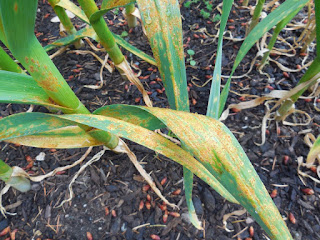 |
| Rust on garlic leaves |
What to do?
I imagine that there are chemical controls for this, but I didn't even investigate that. I got out a pair of ancient dressmaking scissors that are never used in the garden. Wearing a new pair of gardening gloves, I snipped all the lower leaves from the plants and affected portions of upper leaves.
 |
| Sad looking garlic planting with affected leaves removed |
Prevention of future outbreaks
I won't grow any members of the Allium family in this bed for 2 or 3 years - onions, leeks, garlic. Watering in the morning only is important and water the ground, not the leaves. You don't want the plants to spend the cool nights with water on their leaves if you can help it.
 |
| Affected leaves headed for the burn pile |
I have learned a lesson from this. Now that I know what it looks like, next time I see rust on garlic (or any Allium) I'll remove it immediately. If we experience another extremely wet spring, I might consider putting plastic over the garlic to keep it dry. Crop rotation - which I've always practiced - is important. Any sign of rust will mean that that particular bed is out of action for Alliums for at least 2 years. And having never seen rust on Alliums before, I hope I never see it again!
And one final note from my research. Apparently the bulbs are not affected and it's perfectly safe to use cloves from these bulbs next year. So as usual, I'll save the best bulbs for planting in the fall. And perhaps I'll stick to the varieties that were least affected - Spanish Rioja, Czech and the unnamed variety I've been growing for years. We'll see!
No comments:
Post a Comment